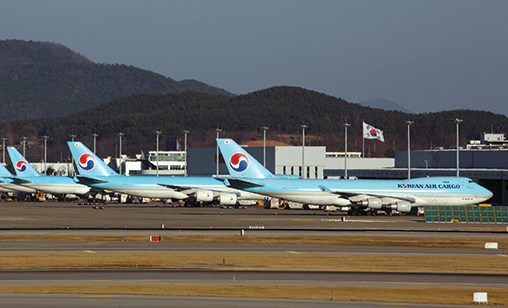Air Cargo
Region’s air cargo business doing it hard
Mixed messages. That was the outlook for the Asia-Pacific’s battered air cargo market as a U.S.-China trade deal appears more likely. The latest statistics reveal air freight traffic remains depressed, but they have improved over earlier results this year and the long-term market is strong, reports associate editor and chief correspondent, Tom Ballantyne, reports.
November 1st 2019
At the world’s biggest cargo hub, Hong Kong, one of the industry’s major air freight operators, Cathay Pacific Airways, last month revealed a hint of optimism in its latest freight statistics. Read More » Cathay and its subsidiary, Cathay Dragon, carried 172,637 tonnes of cargo and mail in September, a drop of 4.4% over the same month last year, but it was better than the overall 6.8% decline in tonnage for the nine months to September 30.
“As anticipated, our cargo business showed signs of improvement compared with August as we stepped into air freight’s traditional high demand season,” said Cathay’s chief customer and commercial officer, Ronald Lam.
 |
“Most markets saw a better month-on-month performance and we mounted a number of charter operations on top of our scheduled services to meet added demand for air freight coinciding with the release of new electronic products.
“However, the overall market remains challenging and competitive with tonnage carried and load factor for the year to date still significantly below the same period last year.”
Hit hard by five months of anti-government protests in Hong Kong, the airline is under no illusions about its short-term business prospects. “Our expectation is that the rest of 2019 will remain incredibly challenging for the airline and our second half financial results are expected to be below those of our first half,” the airline said.
Dimming this glimmer of hope was a warning from the International Air Transport Association (IATA). It said: “the impact of the U.S.-China trade war on air freight volumes was the clearest indicator yet. Year-on-year demand fell by 3.9%.
“Not since the global financial crisis in 2008 has demand fallen for 10 consecutive months. This is deeply concerning. And with no signs of a détente on trade, we can expect the tough business environment for air cargo to continue. Trade generates prosperity. Trade wars don’t. That’s something governments should not forget,” said IATA’s director general and CEO, Alexandre de Juniac.
“Trade tensions are weighing heavily on the entire air cargo industry. Higher tariffs are disrupting not only trans-Pacific supply chains but also worldwide trade lanes.” If these trends continued, he added, 2019 could be the first year since 2009 that the global air freight market contracted.
Figures for global air freight released by IATA last month showed demand, measured in freight tonne kilometers (FTKs), contracted by 3.9% in August compared with a year ago. At the same time, freight capacity rose by 2% year-on-year, meaning capacity growth has outstripped demand growth for the 16th consecutive month.
 |
IATA said trade in emerging countries has been underperforming advanced nations most of this year. “This is due to higher sensitivity of the emerging economies to trade tensions, rising political instability and sharp currency depreciation in some of the key emerging markets,” it said.
Global export orders continue to fall. The global Purchasing Managers Index (PMI) remains in contraction territory. Its tracking of new manufacturing export orders has pointed to falling orders since September 2018. And for the second month in a row, all major trading nations reported falling orders.
IATA said Asia-Pacific airlines reported demand for air freight contracted by 5% in August, compared with the same period in 2018. “The U.S.-China trade war and the slowdown in the Chinese economy have significantly impacted this region. The temporary shutdown of Hong Kong International Airport – the largest cargo hub in the world –added additional pressure. With the region accounting for more than 35% of total FTKs, this performance is the major contributor to the weak industry-wide outcome,” it said.
Elsewhere in Asia, Singapore Airlines saw its freight loads drop 7.4% and cargo load factors decline by 5.6 points. In Korea, where there is trade uncertainty because of a dispute with Japan, Asiana Airlines and Korean Air (KAL) suspended some domestic freight services. Both carriers reported losses in the second quarter because of strong competition, general market conditions and the weakness of the Korean Won.
Korean Air Cargo has changed its international freighter network to mirror a shift in production sites to Southeast Asia. It has re-launched cargo flights to Manila and added services to Bangkok, both with B777F capacity. The change was made because there has been a “continuous rise as global companies shift their production bases to Southeast Asia”, said the airline. KAL said there was rising demand for items such as IT devices, automobile parts and hard disks.
 |
In May, KAL inaugurated a freighter route on an Incheon – Xi’an – Hanoi rotation and increased freighter capacity on its Incheon – Hanoi – Delhi – Vienna – Milan service from three to four times a week. “The added frequency has expanded air cargo transportation on these routes, carrying items such as mobile phones from Hanoi to Delhi, garments from Delhi to Vienna and Milan and electronic devices from Xi’an to Hanoi,” it said. “To cope with global economic uncertainties Korean Air will continue to strengthen its competitiveness in the cargo business by developing new markets and attracting new demand,” it added.
In the longer term, analysts continue to forecast a strong recovery and bullish times for air cargo. In a report, “Asia Pacific Air Cargo Market to 2027”, released last month by ResearchAnd Markets.com, the region’s air cargo market accounted for $37.63 billion in 2018 and is expected to grow at 5.2% annually for eight years and reach $59.13 billion by 2027.
“The rapid growth of the e-commerce sector in the region and rising demand from temperature-sensitive products are the key drivers propelling the growth of the air cargo market. Moreover, airport infrastructure in Southeast Asian countries is supporting national carriers in expanding air freight, which in turn is expected to boost air cargo market growth in the forecast period.”
It said air cargo stakeholders have a tremendous opportunity in Southeast Asian countries such as Singapore, Thailand, Indonesia, and others. Southeast Asian airports are the fastest growing airports in the world. In November 2018, The Association of Southeast Asian Nations (ASEAN) economic ministers signed an agreement to facilitate cross border e-commerce between ASEAN members.
| Asia’s record drop in freight traffic in September Escalating trade tensions, geo-political and economic risk and weak new export orders shaped the air cargo market for the month of September, the International Air Transport Association (IATA) reported in its latest Air Freight Market Analysis. “In seasonally adjusted terms, global freight tonne kilometres (FTKs) trended broadly sideways in the past few months,” the analysis said. “Air freight capacity continued to grow modestly, up 2.1% year-on-year to September 30. Freight load factor is 3.2 percentage points lower than its level a year ago.” “Turning to the Asia-Pacific, the largest region for freight volumes, international FTKS were a substantial 5.9% lower in September than a year ago,” IATA said. “This key global manufacturing and distribution hub has borne the brunt of the weakness in trade and air freight volumes in the last 12 months or so. “The region was the first [in the world] to post a year-on-year decline in FTKs dating back to 2018. More recently, the disruption to airline operations in Hong Kong has created additional challenges for the industry in the Asia-Pacific.” |